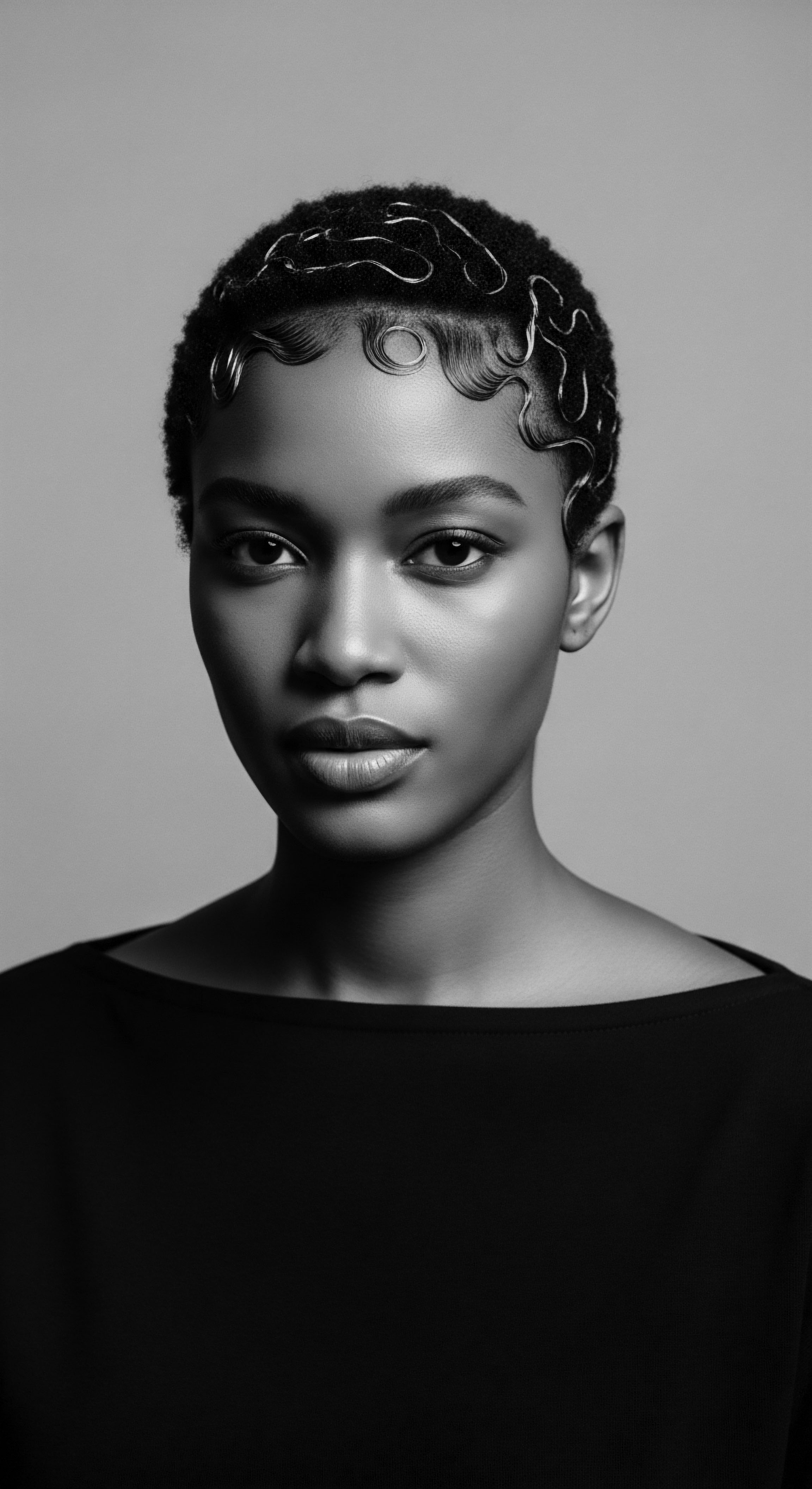
Roots
Consider, for a moment, the very earth beneath our feet, ancient and whispering secrets. It is from this primal source that so much of our human story unfolds, and within that story, the tale of textured hair care finds its earliest chapters. For millennia, before synthetic compounds or complex chemical formulations came into being, humanity looked to the natural world for sustenance, healing, and indeed, for beauty and maintenance of the body. Among these gifts from the soil, natural clays hold a venerable place, their fine particles and mineral-rich composition offering unique properties that lent themselves effortlessly to the intricate needs of coils, kinks, and curls.
Their role was not merely functional; it was deeply interwoven with the rhythms of daily life, community, and the very expression of identity across diverse ancestral landscapes. To truly grasp the historical presence of natural clays in textured hair care, we must first allow our senses to connect with the raw materials themselves, understanding their origins and the intrinsic qualities that made them so invaluable. This journey takes us back to the Earth’s generous embrace, where the story of hair and soil began its enduring alliance.

Elemental Origins The Earth’s Gift
The origins of natural clays are as old as the mountains and rivers themselves, formed over eons through the weathering of rocks. Rain, wind, and the relentless march of time break down bedrock into incredibly fine particles, often rich in silica, alumina, and a fascinating spectrum of trace minerals. These geological processes result in distinct types of clay, each possessing its own unique mineral signature and characteristic feel. Picture the smooth, almost silken quality of kaolin, born from the decomposition of feldspar, or the remarkable swelling properties of bentonite, a product of volcanic ash.
These earthen treasures, found in various hues from the palest white to deep russet reds, became readily accessible to early communities worldwide. Their very accessibility, coupled with their observable physical properties—their ability to absorb, to cleanse, to bind, and to soothe—made them immediate candidates for a host of human applications, including the intricate care rituals for textured strands.

Early Human Connections Clay as a First Conditioner
In the dawn of human existence, every resource was carefully considered, every natural offering understood for its utility. Early civilizations, particularly those in arid or semi-arid regions where access to abundant fresh water for cleansing might have been scarce, discovered the remarkable cleansing and conditioning attributes of various clays. Their fine particulate structure, combined with their inherent electrical charge, allowed them to bind with impurities, excess oils, and environmental residues on both scalp and hair. This made them ideal for purifying rituals that extended beyond simple hygiene, becoming acts of self-care and maintenance.
Archaeological evidence, though sometimes subtle, points to the presence of mineral compounds and earth pigments in ancient grooming kits. For textured hair, which often benefits from gentle cleansing that does not strip it of its vital natural oils, these clays provided an unparalleled solution. They offered purification without harshness, leaving hair feeling soft and prepared for styling. This gentle action, allowing the hair’s natural moisture to persist, would have been particularly advantageous for maintaining the flexibility and strength of coiled and kinky textures.

Understanding Hair’s Design An Ancestral Lens
Ancestral communities, without the aid of microscopes or chemical analysis, possessed an intuitive and profound grasp of textured hair’s design and its particular needs. They recognized its delicate coil, its tendency towards dryness, and its powerful ability to hold shape when properly prepared. This deep understanding, honed through generations of observation and practice, guided their choice of natural ingredients. Clays, with their unique capacities, became a natural ally.
For early communities, clays offered a gentle, effective means to cleanse and condition textured hair, a practice rooted in deep observational wisdom.
The earth’s clays served a spectrum of purposes:
- Cleansing ❉ Their absorbent qualities allowed them to lift away dirt and sebum without harsh detergents.
- Detangling ❉ The slippery consistency of some clay mixtures could aid in separating tangled strands.
- Soothing ❉ Many clays possessed anti-inflammatory properties, providing comfort to the scalp.
- Protecting ❉ When applied as masks or coatings, clays could shield hair from environmental aggressors like sun and dust.

Rhassoul Clay A North African Heritage
One of the most compelling examples of clay’s historical presence in textured hair care stems from the Maghreb region of North Africa, particularly Morocco. For over a millennium, Rhassoul Clay (also known as ghassoul) has been a cornerstone of traditional bathing and hair care rituals. Its very name, derived from the Arabic word “ghassala,” meaning “to wash,” speaks to its primary function.
Excavated from deposits found only in the Atlas Mountains, rhassoul clay stands out for its exceptional mineral composition, particularly high in silica and magnesium. Its historical journey is well-documented ❉ it was traded across the Middle East and Europe as far back as the 12th century, prized for its superior cleansing and conditioning properties for skin and hair.
In communal hammams, women meticulously prepared rhassoul clay, mixing the sun-dried lumps with water to create a smooth, rich paste. This paste was then applied generously to the entire body and hair. For textured hair, rhassoul offered a gentle, non-stripping cleanser that left strands remarkably soft and manageable. It reduced frizz, improved elasticity, and left a perceptible sheen, all without the harshness of modern soaps.
The enduring use of rhassoul clay over centuries, a practice passed down through generations, underscores its efficacy and its central place in the hair care traditions of Moroccan and broader North African communities. Its continued relevance today in global beauty markets is a powerful echo of this deep ancestral wisdom.
| Clay Variety Rhassoul Clay (Morocco) |
| Historical Application (Heritage Focus) Used for cleansing and conditioning in hammam rituals; prized for softening and detangling coils. |
| Modern Scientific Link (Roothea's Lens) High in minerals like magnesium and silica, providing ion exchange and drawing out impurities while conditioning. |
| Clay Variety Kaolin Clay (Global) |
| Historical Application (Heritage Focus) Often used in lighter cleansing and as a base for hair ointments due to its gentle nature. |
| Modern Scientific Link (Roothea's Lens) Composed primarily of kaolinite, a soft, fine clay that is mild and less absorbent, suitable for sensitive scalps. |
| Clay Variety Bentonite Clay (Global) |
| Historical Application (Heritage Focus) Historically used for deep cleansing and detoxification of scalp and hair; valued for its drawing power. |
| Modern Scientific Link (Roothea's Lens) Rich in montmorillonite, it expands when wet, possessing strong negative charge for adsorbing toxins and heavy metals. |
| Clay Variety These clays demonstrate a consistent historical recognition of their unique properties, now supported by contemporary science. |

Ritual
The preparation and application of natural clays for hair care transcended mere routine; they became a ritual, imbued with intention, community, and often, a spiritual resonance. These practices, honed over countless generations, speak volumes about the deep connection between ancestral wisdom and the physical care of textured strands. A historical look at these rituals offers a vivid glimpse into how cultures preserved and celebrated the health and beauty of hair, utilizing the earth’s bounty with mindful precision.

Ancient Hands Sacred Rites
The process began with the careful selection and preparation of the clay itself. Depending on the region and the specific clay, this could involve sun-drying the raw earth, crushing it into a fine powder, and then sifting it to remove impurities. Water, often infused with herbs or fragrant oils, was then gradually added, transforming the dry powder into a smooth, pliable paste. This act of mixing was not simply a mechanical task; it was often a communal endeavor, a moment of shared knowledge and connection.
Women, particularly, gathered to prepare these mixtures, sharing stories, passing down techniques, and reinforcing social bonds. The paste, once ready, was applied with skilled hands to the hair and scalp, working it through each section, ensuring every curl and coil received its nurturing coat. The application itself was a patient, mindful act, often accompanied by gentle massaging of the scalp, stimulating circulation and soothing the skin. This communal aspect of care, where knowledge flowed freely and support was readily available, forms an integral thread in the rich fabric of textured hair heritage.

Tools of the Earth Utensils for Hair Care
The tools employed in these clay rituals were as organic and elemental as the clays themselves. Foregoing elaborate implements, ancestral communities relied on what the immediate environment offered. Smooth stones might have been used to grind the dried clay into a powder. Gourd shells, hollowed out and cleaned, served as mixing bowls.
Fingers, the most sensitive and versatile of tools, were paramount for applying the clay, ensuring even distribution and gentle working of the mixture into the hair. Combs, often crafted from wood, bone, or even thorns, were then used, if at all, for careful detangling once the clay had softened the strands. This simplicity in tooling underscores a profound self-sufficiency and a harmonious relationship with the natural world, where efficacy arose from understanding the material and the hair, rather than from manufactured complexity.
The careful preparation and communal application of clays for textured hair were deep-rooted rituals, often involving simple, natural tools and shared wisdom.

Transformed Strands Clay’s Role in Styling
While primarily recognized for their cleansing attributes, clays also played a considerable part in preparing textured hair for various traditional styles. The softened, often more pliable state of the hair after a clay application made it easier to manipulate. Coils and kinks, notorious for their spring and occasional resistance, became more amenable to stretching, braiding, and shaping. Clays could reduce shrinkage temporarily, making certain protective styles, such as cornrows, twists, or intricate updos, easier to achieve and maintain.
Furthermore, certain clays, when mixed with oils or plant extracts, could also help to set a style or provide a light hold, offering an early form of natural styling aid. This functionality highlights how clays served a dual purpose ❉ they addressed both the fundamental health of the hair and the aesthetic and structural requirements of diverse heritage styles.

Global Echoes Diasporic Adaptations
As communities moved, whether through migration, trade, or forced displacement, so too did knowledge of hair care traditions. The widespread availability of various earth materials meant that even in new lands, analogues to familiar clays could often be found and adapted. In the Americas and the Caribbean, for example, descendants of enslaved Africans, often stripped of their traditional tools and ingredients, demonstrated incredible ingenuity and resilience. They adapted available natural resources, continuing to use local clays and mineral-rich soils, sometimes mixed with plant extracts or animal fats, to cleanse, condition, and style their hair.
These adaptations, born of necessity and maintained through generational teaching, became new branches on the tree of textured hair heritage, ensuring that the wisdom of the earth continued to nourish and adorn strands even under the harshest conditions. The enduring legacy of these practices is a powerful reminder of how cultural continuity can persist, even thrive, amidst profound change.

Relay
To truly appreciate the enduring legacy of natural clays in textured hair care, we must bridge the chasm between ancient practice and modern scientific understanding. This bridge allows us to recognize that ancestral wisdom was not simply folklore; it often rested upon an intuitive grasp of principles that contemporary science can now articulate with precision. The continued use of clays today, both in traditional contexts and in commercial products, represents a powerful relay of knowledge, passing from one generation to the next, from the earth to our hands, and from historical observation to laboratory validation.

The Science Beneath the Soil Mineral Composition and Action
The effectiveness of clays in hair care can be largely attributed to their unique mineral composition and crystalline structure. At their core, most clays are phyllosilicates, meaning they have a layered structure. This layered design gives them remarkable properties. For instance, bentonite clay, a popular choice for textured hair, contains a high percentage of montmorillonite.
This mineral is a type of smectite clay, known for its ability to swell significantly when wet. This swelling action allows it to absorb large quantities of water and, critically, to adsorb impurities.
What makes clays particularly adept at cleansing without stripping is their negative electrical charge. Hair, especially textured hair, can accumulate positively charged impurities from daily life—pollutants, product buildup, and even hard water minerals. Clays act like magnets, attracting these positively charged particles. This process, known as Adsorption, pulls dirt and excess oils from the hair and scalp, holding them within the clay’s expansive surface area, ready to be rinsed away.
Simultaneously, clays also exhibit Absorption, drawing liquids and dissolved substances deep into their internal structure. This dual action allows for thorough cleansing while leaving the hair’s vital natural moisture intact, a stark contrast to harsh, stripping shampoos that can leave textured hair feeling brittle and dry.

Clay’s Contribution to Scalp and Strand Health A Scientific Look
Beyond their cleansing prowess, natural clays offer a spectrum of benefits that support overall scalp and hair wellness, echoing the holistic care observed in ancestral practices. Their mineral content is not merely inert; specific minerals contribute to physiological processes beneficial for hair health.
- Detoxification ❉ The aforementioned adsorption capacity helps to draw out environmental toxins and product residues that can clog follicles and irritate the scalp. This gentle detoxification promotes a healthier environment for hair growth.
- PH Balance ❉ Many clays possess a slightly alkaline pH, which can help to neutralize excess acidity on the scalp, restoring a more balanced environment conducive to healthy hair growth and reducing irritation.
- Soothing and Anti-Inflammatory Properties ❉ Minerals like magnesium and silica, prevalent in clays such as rhassoul and kaolin, are known for their calming effects on the skin. For sensitive or irritated scalps, clay masks can offer a soothing respite, reducing itchiness and redness.
- Mineral Enrichment ❉ While not a primary source of hair nutrition, the trace minerals present in clays can offer subtle conditioning benefits, contributing to hair’s overall resilience and sheen. They can also temporarily fortify the hair cuticle.

Societal Mirror Clay and Identity
The historical adoption and enduring preference for natural ingredients like clays for textured hair care also served as a profound societal statement. In many parts of the world, particularly within diasporic communities, natural hair became a powerful symbol of identity, resistance, and self-acceptance in the face of imposed beauty standards. The conscious decision to use earth-derived materials, rather than chemically altered or industrially produced alternatives, became an act of affirming ancestral heritage and a rejection of narratives that devalued natural textures.
This choice connected individuals to a legacy of self-sufficiency, ingenuity, and a deep respect for the earth’s gifts. The rituals surrounding clay application were not just about hair; they were about reclaiming space, reaffirming cultural ties, and nurturing a sense of belonging rooted in shared history.
The scientific properties of clays, like their adsorptive power and mineral content, validate the historical wisdom of their use for cleansing and conditioning textured hair.

Rhassoul Clay A Case Study in Enduring Efficacy
A powerful testimony to the historical efficacy of natural clays is the extensive, multi-generational use of rhassoul clay, particularly by women of Moroccan heritage. A study in the International Journal of Cosmetic Science notes rhassoul clay’s properties, reinforcing its historical use. This clay has been documented not just as a cleansing agent, but as a material that genuinely improves hair’s manageability, softness, and elasticity, qualities especially valued for textured hair types . Its chemical composition, notably high in specific minerals, contributes to its superior cation exchange capacity, allowing it to effectively draw impurities from the hair and scalp.
The consistent transmission of knowledge regarding rhassoul’s preparation and application through familial lines highlights its undeniable role in traditional hair care. This continuity of practice, spanning centuries, serves as a living laboratory, demonstrating the clay’s sustained benefits for textured hair without the need for modern chemical enhancements.

Sustaining the Legacy Modern Applications and Traditional Wisdom
Today, the legacy of natural clays in textured hair care continues, thriving in both traditional homesteads and contemporary product lines. Many modern formulations for coils and kinks include clays like bentonite, kaolin, and rhassoul, drawing directly from the historical insights of their efficacy. This contemporary adoption underscores a collective recognition that the ancestral paths to hair wellness remain profoundly relevant. There is a growing appreciation for ethically sourced, minimally processed ingredients, echoing the original spirit of working in harmony with the earth.
The relay of this wisdom involves not only incorporating these clays into new products but also respecting the heritage of their use, understanding the specific rituals that surrounded them, and acknowledging the deep cultural connections they represent. The journey of clays, from ancient earth to modern strand, is a vivid representation of how the soul of a strand remains connected to its roots, sustaining a vibrant heritage of care.

Reflection
The journey through the historical role of natural clays in textured hair care invites us to consider more than just minerals and their properties. It calls us to reflect on the enduring wisdom embedded within ancestral practices, a wisdom that saw the earth not just as ground to walk upon, but as a wellspring of profound care. From the primordial alliance of soil and strand to the intricate rituals passed down through generations, clays stand as a quiet, yet mighty, symbol of heritage and resilience.
They remind us that the path to vibrant hair has always been, at its core, a conversation with nature, a respectful communion with the very elements that form us. In every softened coil, in every cleansed scalp, in every moment of tender care, the echoes of this ancient alliance persist, whispering stories of ingenuity, community, and the unbound spirit of textured hair, eternally connected to the deep well of our collective past.

References
- El Boukhari, B. et al. “Chemical and Mineralogical Characterization of Moroccan Ghassoul Clay ❉ A Traditional Medicinal Clay.” International Journal of Cosmetic Science, 41.2 (2019) ❉ 173-181.
- Opdyke, D. L. J. “Monographs on Fragrance Raw Materials ❉ Rhassoul Clay.” Food and Chemical Toxicology, 22.8 (1984) ❉ 663.
- Ross, E. “African Women ❉ Their Struggle for Economic Independence.” Zed Books, 1995. (General context on traditional African practices)
- Asiedu, P. “The Role of African Traditional Medicine in Primary Health Care.” Journal of Pharmacy Practice, 2.2 (1989) ❉ 110-116. (General context on traditional natural remedies)
- Smit, E. et al. “The History of Skin and Hair Care in Africa.” Clinical Dermatology, 30.6 (2012) ❉ 649-654.
